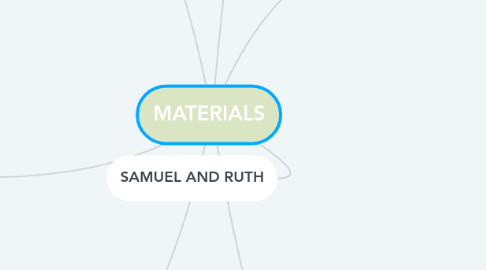
1. PROPERTIES
1.1. Physical properties
1.1.1. Density
1.1.2. Electrical
1.1.3. Optical
1.2. Mechanical properties
1.2.1. Hardness
1.2.2. Tenacity/Fragility
1.2.3. Melleability
1.2.4. Ductility
1.2.5. Elasticity
1.2.6. Plasticity
1.2.7. Mechanical resistence
1.3. Chemical properties
1.3.1. Oxidation
1.3.2. Corrosion
1.4. Ecological poperties
1.4.1. Recyclability
1.4.2. Toxicity
1.4.3. Biodegradability
2. TECHNOLOGICAL PRODUCTS
2.1. Manufactured products
2.2. Examples
2.2.1. Books
2.2.2. Bottle
2.2.3. Table
2.2.4. Chairs
3. CHOICE OF MATERIALS
3.1. Price
3.2. Properties
3.2.1. Examples
3.2.1.1. Resistance
3.2.1.2. Hardness
3.2.1.3. Flexibility
3.3. Availability
3.3.1. Examples
3.3.1.1. Abundance
3.3.1.2. Proximity
3.4. Impact of the enviroment
3.5. Manufacturing properties
4. SAMUEL AND RUTH
5. NATURAL RECOURCES
5.1. Found in nature
5.2. Examples
5.2.1. Plants 🌿
5.2.2. Mines 🚂
5.2.3. Oil and gas wells 🛤
5.2.4. Animals 🐫
6. RAW MATERIALS ORIGINS
6.1. Animals
6.1.1. Examples
6.1.1.1. Silk
6.1.1.2. Wool
6.1.1.3. Hides
6.2. Plant
6.2.1. Examples
6.2.1.1. Wood
6.2.1.2. Cotton
6.2.1.3. Flax
6.2.1.4. Cork
6.3. Minerals
6.3.1. Examples
6.3.1.1. Slate
6.3.1.2. Sand
6.3.1.3. Marble
6.3.1.4. Iron ore
6.3.1.5. Copper ore
6.3.1.6. Oil
7. MATERIALS FOR TECHNICAL USE
7.1. Obtained from raw materials
7.2. Exampes
7.2.1. Wooden
7.2.1.1. Examples
7.2.1.1.1. Natural
7.2.1.1.2. Prefabricated
7.2.2. Plastic
7.2.2.1. Examples
7.2.2.1.1. PVC
7.2.2.1.2. Cellophane
7.2.3. Metallic
7.2.3.1. Examples
7.2.3.1.1. Containing iron
7.2.3.1.2. Doesn't contain iron
7.2.4. Stone
7.2.4.1. Examples
7.2.4.1.1. Glass
7.2.4.1.2. Plaster
7.2.4.1.3. Cement
7.2.5. Ceramic
7.2.5.1. Examples
7.2.5.1.1. Porcelain
7.2.5.1.2. Ceramics
7.2.6. Textile
7.2.6.1. Examples
7.2.6.1.1. Natural
7.2.6.1.2. Artificial
